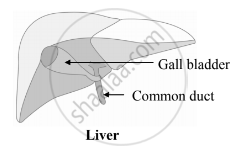Advertisements
Advertisements
प्रश्न
उत्तर

APPEARS IN
संबंधित प्रश्न
The gall bladder temporarily stores bile.
Match the items of Column I with suitable items in Column II.
| Column I | Column II | ||
| (a) | Salivary gland | (i) | Bile juice secretion |
| (b) | Stomach | (ii) | Storage of undigested food |
| (c) | Liver | (iii) | Saliva secretion |
| (d) | Rectum | (iv) | Acid release |
| (e) | Small intestine | (v) | Digestion is completed |
| (f) | Large intestine | (vi) | Absorption of water |
| (vii) | Release of faeces |
Describe one way in which the small intestine is adapted for the absorption of digested food.
What is the special name of the contraction and expansion movement which pushes the food further in our digestive tract (or alimentary canal)?
If the saliva is lacking in salivary amylase, then which of the following processes taking place in the buccal cavity will be affected?
(a) proteins breaking down into amino acids
(b) starch breaking down into sugars
(c) fats breaking down into fatty acids and glycerol
(d) intestinal layer breaking down leading to ulcers
Fill in the blank.
The _______ is a common opening of food pipe and windpipe
State whether the following statement is True or False.
Saliva changes starch into maltose.
Answer in detail.
Name the four types of teeth and their functions
Answer in detail.
What changes occur in food in the mouth?
Correct the spellings: Disegion
Circle the odd one.
Throughout the length of the alimentary canal the layer which shows the presence of goblet cells is ______
The pyloric sphincter guards the passage between the ____________.
Identify the correct human dental formula.
Identify which three of the following terminologies is true for human dentition.
The process of digestion is completed by:
Name the organism which lives in the digestive system of human ______.
Which part of the alimentary canal receives bile from the liver?
In which part of the alimentary canal food is finally digested?
Choose the correct order of terms that describes the process of nutrition in ruminants.
